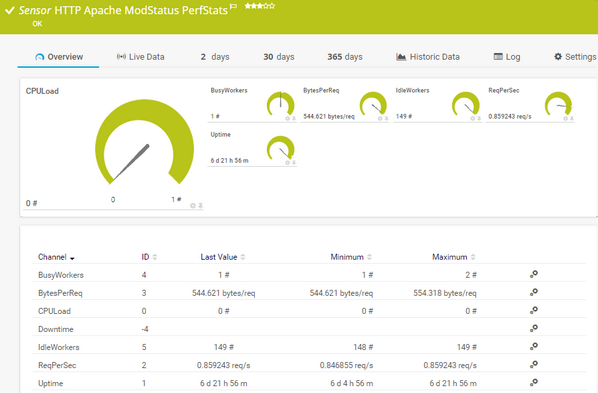PRTG Manual: HTTP Apache ModStatus PerfStats Sensor
The HTTP Apache ModStatus PerfStats sensor monitors performance statistics of an Apache web server via mod_status over HTTP.
This sensor implicitly supports SNI, an extension to the Transport Layer Security (TLS) protocol.
For a detailed list and descriptions of the channels that this sensor can show, see section Channel List.
- Dutch: HTTP Apache ModStatus PerfStats
- French: Apache ModStatus PerfStats (HTTP)
- German: HTTP Apache ModStatus PerfStats
- Japanese: HTTP Apache ModStatus 性能統計
- Portuguese: PerfStats Apache ModStatus (HTTP)
- Russian: HTTP Apache ModStatus — стат. произв-сти
- Simplified Chinese: HTTP Apache ModStatus PerfStats
- Spanish: PerfStats Apache ModStatus (HTTP)
Consider the following remarks and requirements for this sensor:
Remark |
Description |
|---|---|
SRP ciphers |
This sensor does not support Secure Remote Password (SRP) ciphers. |
Smart URL replacement |
This sensor supports smart URL replacement. |
IPv6 |
This sensor supports IPv6. |
Performance impact |
This sensor has a low performance impact. |
Knowledge Base |
Knowledge Base: Which HTTP status code leads to which HTTP sensor status? |
The sensor has the following default tags that are automatically predefined in the sensor's settings when you add the sensor:
- apache
- httpsensor
- httpapachemodstatusperfstatssensor
For more information about basic sensor settings, see section Sensor Settings.
Setting |
Description |
|---|---|
Timeout (Sec.) |
Enter a timeout in seconds for the request. Enter an integer. The maximum timeout value is 900 seconds (15 minutes).
|
URL |
Enter the URL to the mod_status module on your Apache server. PRTG automatically appends /server-status?auto to it. If you enter an absolute URL, the sensor uses this address independently of the IP Address/DNS Name setting of the parent device.
|
Setting |
Description |
|---|---|
Authentication |
Define if authentication is necessary on the web page:
|
User Name |
This setting is only visible if you select Web page needs authentication above. If the proxy requires authentication, enter the user name for the proxy login. Enter a string. |
Password |
This setting is only visible if you select Web page needs authentication above. Enter a password. |
Authentication Method |
This setting is only visible if you select Web page needs authentication above. Select the authentication method that the URL uses:
|
Setting |
Description |
|---|---|
Primary Channel |
Select a channel from the list to define it as the primary channel. In the device tree, PRTG displays the last value of the primary channel below the sensor's name. The available options depend on what channels are available for this sensor.
|
Graph Type |
Define how this sensor shows different channels:
|
Stack Unit |
This setting is only visible if you select Stack channels on top of each other above. Select a unit from the list. PRTG stacks all channels with this unit on top of each other. By default, you cannot exclude single channels from stacking if they use the selected unit. However, there is an advanced procedure to do so. |
By default, all of these settings are inherited from objects that are higher in the hierarchy. We recommend that you change them centrally in the root group settings if necessary. To change a setting for this object only, click ![]() under the corresponding setting name to disable the inheritance and to display its options.
under the corresponding setting name to disable the inheritance and to display its options.
For more information, see section Inheritance of Settings.
Instead of entering a complete address in the URL field of an HTTP sensor, you can only enter the protocol followed by a colon and three forward slashes (this means that you can enter either http:/// or https:///, or even a simple forward slash / as the equivalent for http:///). PRTG automatically fills in the parent device's IP Address/DNS Name in front of the third forward slash.
Whether this results in a valid URL or not depends on the IP address or Domain Name System (DNS) name of the parent device. In combination with cloning devices, you can use smart URL replacement to create many similar devices.
For example, if you create a device with the DNS name www.example.com and you add an HTTP sensor to it, you can provide values in the following ways:
- If you enter https:/// in the URL field, PRTG automatically creates the URL https://www.example.com/
- If you enter /help in the URL field, PRTG automatically creates and monitor the URL http://www.example.com/help
- It is also possible to provide a port number in the URL field. It is taken over by the device's DNS name and is internally added, for example, http://:8080/
Smart URL replacement does not work for sensors that run on the probe device.
Which channels the sensor actually shows might depend on the target device, the available components, and the sensor setup.
Channel |
Description |
|---|---|
BusyWorkers |
The number of busy worker threads |
BytesPerReq |
The number of bytes per request |
CPULoad |
The CPU load
|
Downtime |
In the channel table on the Overview tab, this channel never shows any values. PRTG uses this channel in graphs and reports to show the amount of time in which the sensor was in the Down status. |
IdleWorkers |
The number of idle worker threads |
ReqPerSec |
The number of requests |
Uptime |
The uptime |
KNOWLEDGE BASE
Which HTTP status code leads to which HTTP sensor status?
What security features does PRTG include?
My HTTP sensors don't work. What can I do?





